"Keep up the good work, if only for a while, if only for the twinkling of a tiny galaxy." -Wislawa Szymborska
Our Milky Way Galaxy is home to not only our Earth and our Solar System, but hundreds of billions of other stars.
Held together by not only the incredible gravity of all of our stars, but by dark gas and dust far outweighing all the stars, and by trillions of suns worth of dark matter as well, our galaxy represents one of perhaps a hundred billion just like it in our vast Universe.

Image credit: NASA, ESA, R. Windhorst, S. Cohen, M. Mechtley, M. Rutkowski, R. O'Connell, P. McCarthy, N. Hathi, R. Ryan, H. Yan, and A. Koekemoer.
But these galalxies are massive and bright. What if I wanted to know what was happening at the other end of the spectrum: the smallest, lightest, dimmest objects in the Universe?!
You would think to look at small, satellite galaxies, like Leo A, above. But with millions of stars in even the smallest dwarf galaxies, we can go much smaller.
You might even think to go to a globular cluster, which is even smaller and less massive, with just hundreds of thousands of stars in most of them.
But very recently, we've been able to do one better. Take a look at this area of the sky, which houses the smallest "mini-galaxy" in the known Universe.
See it? Of course you don't. Most of the stars in this image come from our galaxy, and the mini-cluster, gravitationally bound together, is just a small number of faint stars in this image.
But using the Keck's Deep Extragalactic Imaging Multi-Object Spectrograph (DEIMOS) instrument, they were able to measure how these stars are moving relative to both each other and to the Milky Way galaxy.
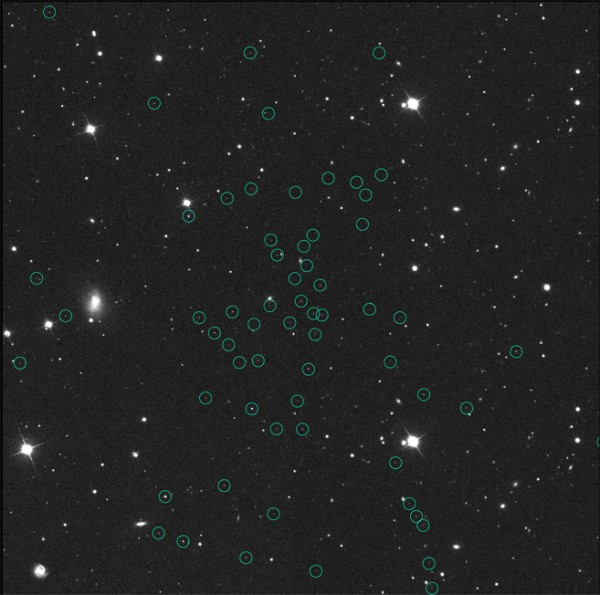
They found that these stars -- part of a collection of only about one thousand -- are all bound together and moving with an average speed of 209 km/s relative to the Milky Way.
If this were just a cluster of 1,000 stars bound together under their own gravity, you'd expect the difference between the fastest and slowest-moving stars to be less than 1 km/s. But astronomers found that the slowest stars were moving at 194 km/s, while the fastest move at 224 km/s, meaning there is a tremendous amount of dark matter!
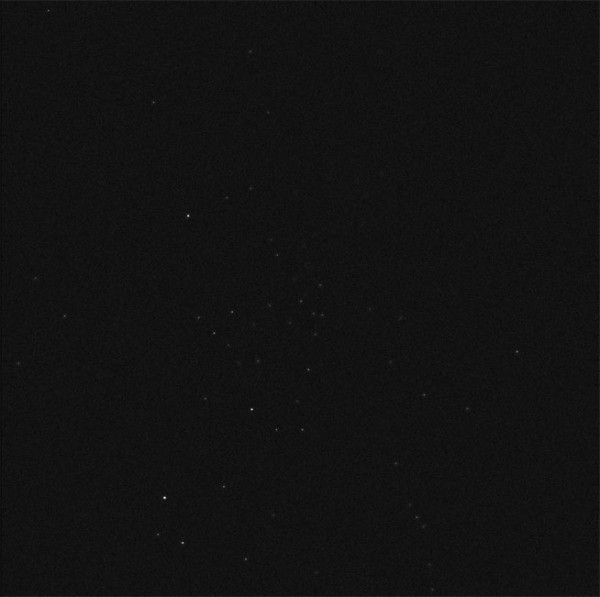
For just 1,000 stars, there is a total mass in this mini-galaxy of 600,000 Solar Masses, meaning that nearly all of the matter in there is dark! With a total mass hovering right around the minimum-sized structure the Universe can form, this is absolutely amazing! It's also one of the oldest objects in the Universe, as pretty much all of the stars are very old, metal poor, Population II stars.
Now this is particularly interesting because one of the things we found, perhaps disturbingly, is that dwarf galaxies (like Leo A, close to the top) have much more dark matter compared to the amount of stars they have versus a galaxy like ours. Proponents of dark matter had to face the fact that -- if there really was a giant halo of dark matter surrounding every galaxy -- the number of stars you formed must be related to the total mass of the galaxy in a non-trivial way.
One of the predictions that this made was that the smaller and smaller your gravitationally bound structure got, you should be forming even fewer stars than you would expect by proportion. With less than 0.03% of the mass of this galaxy in stars (versus about 2% for a galaxy like ours), this prediction is correct!
And so -- in perhaps the most unlikely of places -- the smallest galaxy ever discovered helps us understand dark matter just a little better! Thanks to Tammy Plotner for her article on this story, which brought it to my attention!

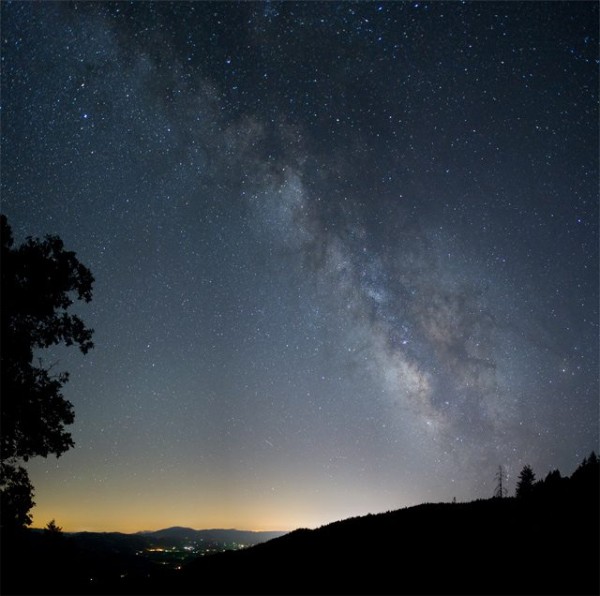
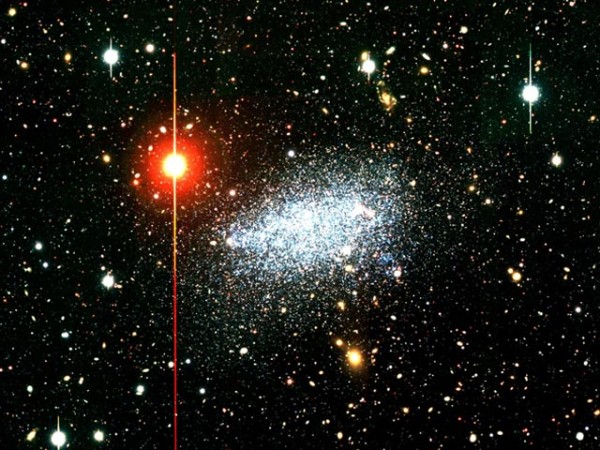
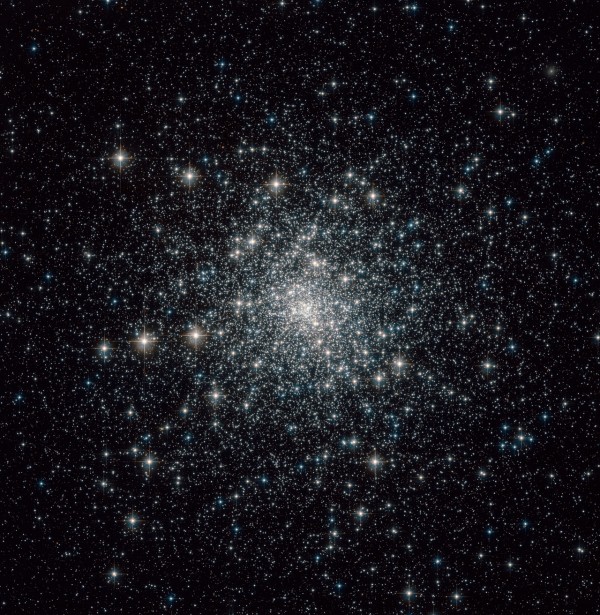
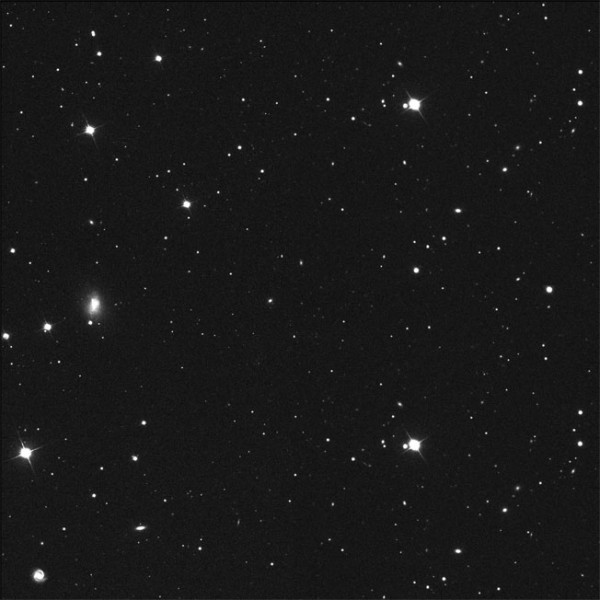
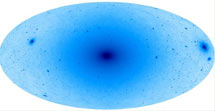
Since I am going to be living forever(23yrs old- come one singularity don't fail me now), I would like to visit these systems. Even if our "virtual realites" will be much more intriguing I would still like to visit these places. We can't leave all the fun to machines, although we will be largely robots, I would still like to keep my brain and genes(stored genes most likely), mainly because I have the sneaking suspicion that copying ones self is not living for ever. So I know it is the same thing as copying,BUT, I would like to keep my brain alive for as long as possible and slowly replace it with nano bot neurons when keeping biological structures is no longer possible.
I was just on another site where the issue of Fermi's Paradox came up. The idea that since a space faring civilization could populate the galaxy in a relatively short time compared to the life of the galaxy, where are they?
It is interesting that this galaxy is very old and has very old stars. If life did occur here early after the Big Bang, then it may have been present for billions of years. What have those civilizations been doing? If they made Dyson spheres, what temperature would they be radiating at? If they still had chemical metabolism, it would likely need to be at about the temperature where water is liquid. But if they have a significant electronic component, they may prefer temperatures where superconduction occurs. The temperature would need to be above the black body background, but there are superconductors with higher transition temperatures than that.
If Dyson spheres were radiating at 10 K, they would not be very visible. Even a few hundred thousand suns hidden behind a 10 K radiator might not be very visible.
If a civilization did control hundreds of thousands of suns with Dyson spheres around them for a few billion years, presumably they would be controlling the progression of those stars on the main sequence and would control approximately when those stars would go nova (and where they are pointing). If so, they could use the gamma ray emissions from the poles as weapons to remove potentially competitive civilizations even from galactic distances.
Awesome!
Wasn't that one of the things they tried to peg MOND on?
WoW! This is one the of the greatest article of my interest, being a child I always watched the sky at night wondering what up there, how many other solar systems, stars & planets are there in this galaxy. The images are very much surprising & has pushed me one step more closer to read about galaxies.
You forgot to give the name of the galaxy: Segue 1. You are not being Google-friendly.
The observations don't know show how much it contains ordinary (baryonic) matter. Since it is so ancient, it must contain lots of star remnants that don't shine anymore. There's dark matter, and there's dark matter.
Very interesting. Let me accept everything that you and the various links and other articles say. And then let me ask a few questions.
You suggest that Segue 1 is a galaxy even though it is smaller than a globular cluster. As well via your link to Jean's instability, you suggest that a galaxy amount of mass of cosmic dust (not a stellar amount of mass) is needed to begin the gravitational collapse process that leads to star formation. Hopefully, I've followed your reasoning correctly so far.
Another article gives the minimum mass for a galaxy at 10 million solar masses.
http://www.astronomy.com/en/News-Observing/News/2008/09/Scientists%20di…
You link to the Jeans instability, but I can't follow it to the point of determining if it gives a minimum sized cosmic dust cloud that can collapse to form an object the size of this mini-galaxy of 600,000 solar masses, or a globular cluster or a full galaxy of at least 10 million solar masses, or even just a star. Or maybe Jeans instability is used for all of the above. Could you clarify this?
I don't dispute that this object has been observed. Nor do I dispute that velocity distributions could be accounted for by 600,000 solar masses of dark matter. Very nice.
But could this very ancient cluster of stars be moving around a relatively massive black hole at it's center of mass?
Thus has anyone looked at this mini-galaxy (Sengue 1), dwarf galaxies or globular clusters for relatively massive black holes at their centers? And if not could an extra large black hole account for the wider velocity distribution or is dark matter the only candidate explanation for such velocity distribution?
Two further questions: Do the most distant galaxies have relatively larger black holes at their centers than (similar in mass) near galaxies? or ditto, Do the most distant galaxies have relatively larger black holes at their centers than (similar in mass) near galaxies?
I assume we don't know; but maybe...
daedalus2u @2, this mini-galaxy already has a significant fraction of the oldest known stars. Something like one out of a million Milky Way stars are this old and metal-poor, while nearly all of them in this mini-galaxy are. It makes it very unlikely for enough heavy elements to exist there to form chemical-based life.
Sili @3, I am sure that MOND advocates will try to reconstruct a rotation curve (or velocity-dispersion graph) for this mini-galaxy, it will (like practically all galaxies) be flat, and they will talk about how it is a problem for dark matter. It is far more likely -- to me, at any rate -- that dark matter is correct, and the MOND phenomenon is due to dark matter halos surrounding bound structures that have mass-dependent star formation rates and initial mass functions. C'est la vie.
Lassi @5, sorry for the oversight in omitting the name. Segue 1, in fact, is the galaxy's name. Based on our understanding of matter distribution and structure formation throughout the Universe, it is very likely to have the same dark matter-to-baryonic matter ratio as everything else in the Universe: about 5-to-1. It is currently believed that segregation of dark matter from baryonic matter is not feasible in a single object that has undergone monolithic collapse.
OKThen @6, if you use the Jeans instability to determine the minimum mass of a structure that collapses due to fluctuations in the cosmic microwave background, you get a mass of somewhere between 10^5 and 10^6 solar masses. Originally, this was thought to correspond to globular clusters, but it is clear that even the smallest globulars are at least a few times this. There *could* always be a black hole at the center, but if it were gravitationally significant, it would cause the velocity distribution to be very different than if the mass were spread throughout the galaxy. Although I haven't taken a look at the data myself, the calculations are very easy to do, and I have faith that the authors did their due diligence. As for your question @7, there are so few nearby ultra-massive galaxies that we do not have a large enough sample size to determine whether your idea is correct or not.
Thank you Ethan for your answers.
The observations, so far, of this smallest mini-galaxy are spectacularly interesting.
It would be hard to exaggerate how big a deal these Segue 1 observations are. Wow.
The skeptic in me shudders.
Fun post. I always enjoy ones that discuss the extremely large and small.
Side note: Your link to the Dynamics of Cats blog takes you to the old site. Perhaps consider updating it to take you to the new one on scienceblogs.
Can you give a better picture or description of what this means? Is this describing a group of stars all moving together while rotating (with the axis roughly vertical to us)?
Or what?
> "some of the Segue 1 stars are moving at rates as
> slow as 194 kilometers per second while others are
> going as fast as 224 kilometers per second.
Could someone please explain to me why the right side of the Segue 1 images seems to have way too much exact repetition? It looks like the stars in the upper-right corner of the image are identical to the stars in the lower-right corner of the image. Yet this repetition doesn't exist in the overlay of circles (although the stars they circled in that half of the image do repeat).
Is this image faked? What's going on here?
It's definitely not gravitational lensing due to the close proximity and exact squareness of the repetition. It looks more like someone cut-and-pasted those exact sections into the picture. Now, it might be somewhat forgivable if the repeated images also correlated to repeated circles in their overlay. However, the overlay circles different stars in the two repeated section.
This would appear to me to be a falsified image. My first instinct upon seeing this is to ask: Is the story also falsified for some reason?
Oh, also, in addition to the first two pictures looking faked because of the repeated sections, the stars in the last image also exactly match the circled stars in the image with the overlay, which, if the first two images were simple mistakes, wouldn't be possible. I'm seriously concerned about what I'm seeing here.
Mike,
That is a good find on your part; good eye!
Although I don't know Marla, nor am I familiar with the raw images taken with Keck, a little digging shows an image like this:
http://www.newscientist.com/data/images/ns/cms/dn14763/dn14763-1_600.jpg
This tells me that Marla likely has the correct data for the third (subtracted) image, but rather than overlay the appropriate image for the area that Segue 1 is found in, she simply overlaid a stock image of stars. And that stock image of stars happens to have the artifact that you noticed.
I realize I am being generous here in my assumptions, but the only way to know for sure would be to ask her.
Mike,
Wow, you really have a good eye. It took me a while to see what you described. Ethan's generous assumption makes sense; this seems like a publication not a scientific error.
Ethan
Yes, I've mostly put aside skeptical mind to better focus upon understanding mainstream physics and astronomy's explanations. Nevertheless, I speculated that this galaxy was not at the edge of the visible universe despite these being very old stars.
Sure enough, as best as I can tell; this very old galaxy Segue 1 is only 85,000 light years away! Yet the stars and hence the galaxy are over 12 billion years old. Hmm? Now my skeptical mind does not shudder so much.
Obviously, Segue 1 observations are still very supportive of dark matter hypotheses.
But the Segue 1 observation of the oldest galaxy-like object in the universe only 85,000 light years away seems a bit problematic for the big bang theory.
So your opinion please, does Segue 1 create problems for a big bang hypothesis???
The problem being that the most metal free galaxy in the universe is not observed at the end of the visible universe but in our own galactic neighborhood. Wow, Segue 1 literally couldn't be any closer to Earth! It's a "satellite galaxy of the Milky Way"!
So Ethan, if you want to talk about this now or in another Segue 1 post, that'd be nice. Either way, I look forward to future Segue 1 hypothesis and observation. We couldn't get luckier; to have such a galaxy close to Earth. Wow! Wow!
Ethan
From this 2009 report
http://arxiv.org/abs/0906.3669
"Segue 1 is moving with a velocity that is close to one of the (Sagitarrius) wraps... there are enough Sagittarius stars, indistinguishable from Segue 1 stars, to inflate the velocity dispersion... All the available evidence is consistent with the interpretation that Segue 1 is a star cluster, originally from the Sagittarius galaxy, and now dissolving in the Milky Way."
OK, that mitigates the dark matter hypothesis a bit. But and then and so on and so forth. So I await further analysis, observation and insight.
@Ethan Siegel, quoting from post #8
Based on our understanding of matter distribution and structure formation throughout the Universe, it is very likely to have the same dark matter-to-baryonic matter ratio as everything else in the Universe: about 5-to-1.
Do you mean that it isnât possible to work out the actual ratio for a mini galaxy like Segue 1?
An article by Stacey McGaugh of January 2010 states:
"As we looked at smaller objects - individual galaxies and satellite galaxies, the normal matter content gets steadily less," he says. "By the time we reach the smallest dwarf satellite galaxies, the content of normal matter is only ~1percent of what it should be. (Such galaxies' baryon content is ~0.2percent instead of 17percent). The variation of the baryon content is very systematic with scale. The smaller the galaxy, the smaller is its ratio of normal matter to dark matter. Put another way, the smallest galaxies are very dark matter dominated.
Was McGaugh wrong?
Thanks for that image update. I'm not trying to be argumentative or trying to find conspiracies or anything. That just really took me by surprise when I saw it.
Also, in the image that you just linked to, is the image on the right supposed to correlate with stars in the image on the right? It doesn't seem to line up with any. Nor is it the same as the "reduced" image posted in your article. And the reduced image in your article *does* line up perfectly with stars in the repetitive image, but not the newly linked-to image. Which is the true image showing the actual Segue 1 mini-galaxy? And what correlations should I be looking for in the non-reduced imagery? I'd like to see what the galaxy looks like in the context of the original picture, if possible.
Thanks again!
OKThen,
It seems unlikely that this new study would make the same errors as the SDSS study from 2006 that your link refers to. It's important to check all the possible sources of error in your work, but the Keck team makes no mention of this.
Alan,
I don't know whether McGaugh was wrong or not. Stacy's work is generally very good, and if he says that the normal matter content gets less, he is presumably talking about the overall baryon content, not merely the luminous part.
I will not go so far as to state that dark matter cosmologies predict this sort of segregation, as I do not believe that is the case. How the overall baryon content is derived will make all the difference in the world; as far as I can tell, all we can "see" is the stars in a cold, small structure like this. There are definitely fewer stars. If there are fewer baryons overall, on the order of a fraction of a percent, there may well be an astrophysical explanation for it, but it is, to put it lightly, a puzzle at this point.
Ethan, of course that is what observations would show. The metal rich stars that had life or that had the heavier elements to construct things out of have been surrounded by Dyson Spheres and so are no longer visible. ;)
All the younger stars having been tamed, they are likely working on the oldest ones now. If this idea is correct, then there should be fewer binaries visible because binaries would be easier to construct a Dyson Sphere around (I think). It is easier to extract momentum from a binary than it is from a singleton.
I would expect that galaxies that have been âtamedâ should show less dust than a non-tamed galaxy. The dust is what habitats have to be made of, so they wouldn't let it escape from the stars they have tamed.
There might even be more odd-ball stars, stars that are rare to non-existent in non-populated galaxies. There do seem to be more milisecond pulsars. I read about a suggestion to use them as a sort of GPS for planetary space missions. Maybe they are synthetic and that is their actual purpose?
How come the older stars are metal-poor (metals being anything heavier than hydrogen, right?)? Shouldn't older stars be richer in metals?
@Crus Austrailis,
Older stars would be metal poor because they would have formed from the original hydrogen/helium makeup of the universe before it was enriched with metals shed from super nova. If these older stars date from early in the universe then they must be lower on the main sequence than the sun and fusing hydrogen and helium very slowly, and have masses so low that they may never generate heavier metals.
The first stars, those composed only of hydrogen and helium were very large. As there is gravitational collapse, the gas heats up and has to radiate that heat to continue to collapse. Hydrogen and helium must get very hot to ionize and be able to lose heat by thermal radiation. Metals (essentially everything heavier than H2 and He ionize more easily and so radiate at lower temperatures.
Because of the poor thermal radiation of H2 and He, those first stars had to be very large to have sufficient gravitation to form. As very large stars they went through the main sequence very fast, exhausted their fuel and went nova. That generated a lot of metals and dispersed them into the environment and generated shock waves which compressed the ambient gas and started new star formation.
Those second generation stars could be small because they had metals to radiate thermal energy during the gravitational cloud collapse. Those are the small second generation stars observed in this galaxy.
wait a minute. Is this really a mini galaxy? or a cluster which is inside the milky way or even orbiting near the milky way?
Individual stars are visible so it isnt so far away.
Does it have a name?
HAPPY BIRTHDAY, ETHAN!!! AND MANY, MANY MORE!!!
How come the stars at our galaxy do not occupy most of what is seen?
I am very fascinated in the deep space cosmos. i heard the largest known galaxy is named NGC 6872. but, how do we photo-graph our own milky way when we are in it?
also i am only 12